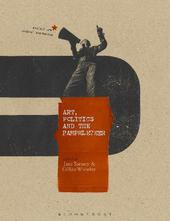
|
Art, Politics and the Pamphleteer
Hardback
Main Details
| Title |
Art, Politics and the Pamphleteer
|
| Authors and Contributors |
Edited by Dr. Jane Tormey
|
|
Edited by Gillian Whiteley
|
| Series | Radical Aesthetics-Radical Art |
|---|
| Physical Properties |
| Format:Hardback | | Pages:384 | | Dimensions(mm): Height 246,Width 189 |
|
| Category/Genre | Philosophy - aesthetics
Social and political philosophy |
|---|
| ISBN/Barcode |
9781350022454
|
| Classifications | Dewey:701.03 |
|---|
| Audience | | Tertiary Education (US: College) | |
|---|
| Illustrations |
250 bw illus
|
|
Publishing Details |
| Publisher |
Bloomsbury Publishing PLC
|
| Imprint |
Bloomsbury Academic
|
| Publication Date |
10 December 2020 |
| Publication Country |
United Kingdom
|
Description
Art, Politics and the Pamphleteer brings together a collection of text-based and visual essays, commissioned artworks and graphics. This richly illustrated book responds to the concept, aesthetics and function of the political pamphlet. It is diverse in content, interpreting the 'pamphlet' in the broadest terms, and encompassing a number of case studies that offer historical or specific examples of contemporary pamphleteering practice that can be seen to perform 'a clear political implication' or protest. Besides exploring the radical history and diverse cultures of the pamphlet, it also celebrates the rich visual rhetoric, typography and contemporary relevance of the format for both artists and activists. Contributions include an historical overview and essays by: Andy Abbott, Angeliki Avgitidu, Aziz Choudry and Desiree Rochat, David Murrieta Flores, Michelle Kempson, Pil and Galia Kollectiv, Rachel Schreiber, Jane Tormey, Gillian Whiteley; visual contributions by Gary Anderson and Steven Shakespeare, Ruth Beale, Ami Clarke, Common Culture, Jeremy Deller, Freee, Patrick Goddard, Gavin Grindon, Ferenc Grof, Marc Herbst, Joanne Lee, Josh MacPhee, Manual Labours, Mark McGowan, Minute Works, Chris Morton, radicalreThink, Hester Reeve, Oliver Ressler, Greg Sholette & Christopher Darling, Laura Wild, Andrew Wilson. As the book was conceived as predominantly visual from the outset, the book concept has been a collaboration with The Little Riot Press (Phil Eastwood and Chris Dunne). Overall, an aesthetic of protest and propaganda was considered integral to the design to reiterate the generally handmade, analogue techniques found in political pamphlets. The Little Riot Press have thus approached the illustration and overall visual cohesion from the perspective of the radical artist pamphleteer. www.thelittleriotpress.com
Author Biography
Gillian Whiteley is Senior Lecturer in Art History and Visual Culture at Loughborough University and author of Junk: Art and the Politics of Trash (I.B.Tauris, 2010). Jane Tormey is Honorary Fellow of the School of Arts, English and Drama at Loughborough University and author of Cities and Photography (2012) and Photographic Realism: Late Twentieth-Century Aesthetics (2017).
ReviewsPassionately engaged, impressively researched and seasonably distilled ... Do not be deceived by its scrappy demeanour. Art, Politics and the Pamphleteer will serve scholars and practitioners of aesthetic engagement in social movements for decades to come. In this service, the collection's wealth of sources, depth of critical appreciation and clarity of expression will enhance any move that builds on it. * Journal of Design History * This book entices us into the prismatic fringe of the 'pamphlet' and its unruly disciple the 'pamphleteer'. True to its object, here design, text, form, matter, and affect fold in and pull apart in multiple ways. Immersed in the present, past, and emerging future of pamphleteering, the book leaves readers in no doubt that this disreputable form presents an adventure in art, politics, and publishing that is poorly served by the word 'writing'. * Nicholas Thoburn, author of "Anti-Book: On the Art and Politics of Radical Publishing" * An absorbing critical anthology of pamphlet formats with the exhilarating whiff of something improvised, uncontrolled, it melds research, personal insights and DIY fanzine monochrome mayhem. Pamphlets are transient, oriented to the moment, but, gathered here, they receive a continued life - tactile too - amidst a spiky volley of political and artistic attitudes. This is history and its reflection, but it is also a manual for future campaigns devising a renewed common culture. * Esther Leslie, Professor of Political Aesthetics, Birkbeck, University of London, UK *
|